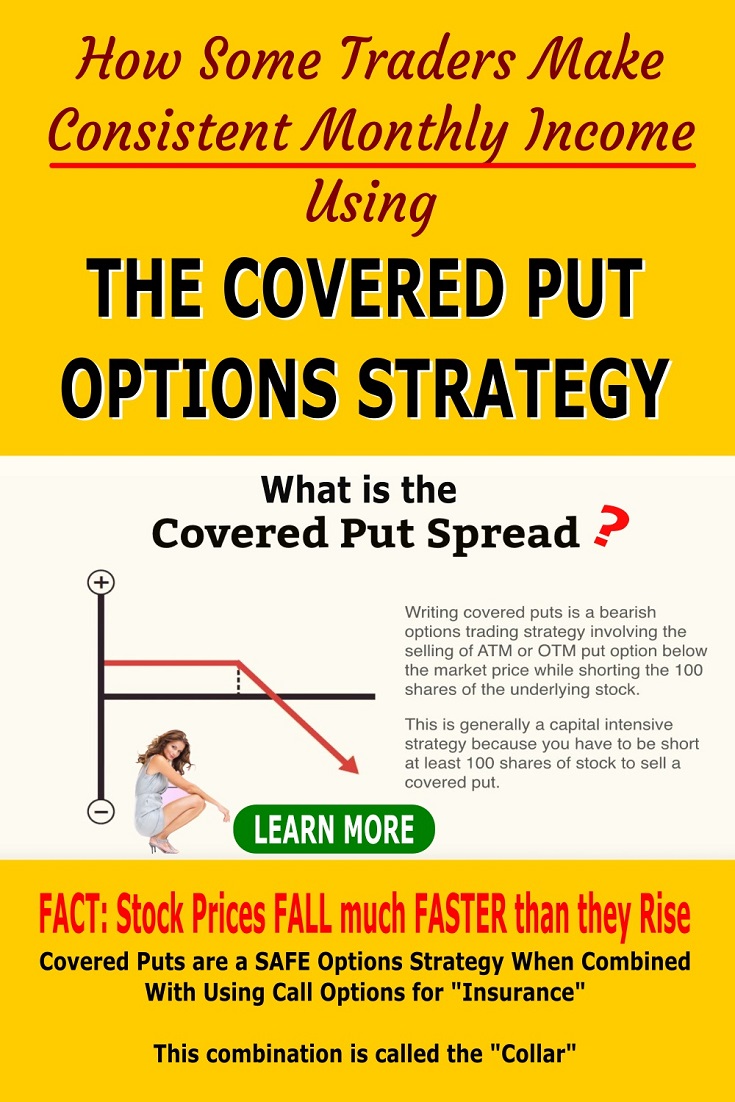Search Options Trading Mastery:
The Covered Put
An Analysis of the Covered Put Strategy
There is a general belief among stock traders that implementing the covered put strategy implies unlimited risk. Whether this belief is true or false we will soon discover. One thing is certain however - this perception prevents many traders from implementing this strategy. Consequently, they lose many profitable trading opportunities.
How the Strategy Works?
The best time to implement the covered put strategy is when you believe that the price action of a stock will either remain stable or fall in the near future - say, up to 6 weeks from now. You sell at-the-money (ATM) put options while simultaneously shorting the underlying stock.
Example:
A stock is trading at $55 in August.
You decide to sell its September $52 put options for $250, on the assumption that the market price for these 'out of the money' puts is $2.50 x 100 shares specified in the contract.
At the same time, you short 100 of the same stock at $55. You receive a credit to your account for $250 while your broker would apply margin to your account.
From here on, the following scenarios may occur:
1. The Stock Price Remains at $55
When the put option expires in September, the stock is trading at $55. You keep the income from selling the puts as profit, while your short position in the stock makes zero loss/profit. Therefore, you earn $250.
2. The Stock Price Falls to $52
When the September option expiration date arrives, the underlying stock price has fallen to $49. The put option you sold expires in the money. Under normal circumstances you would be assigned the stock at $52, losing $300 in the transaction (52 - 49 x 100).
But you would also make $600 from the shares you shorted at $55, so your net profit would be the $250 you received from selling the puts, plus another $300 from shorting the stocks = $550 overall.
This is a 10 percent return on risk for one month. Nice!
3. The Stock Price Increases to $65
When the September option expiration date arrives, the stock price has jumped to $65. Here, you would lose $1,000 on your short position in the stock, but this is offset by the $300 you received from the put options. So your net unrealized loss is $700 ($1000 - $300). This is the only scenario where you would realize a loss if you closed your positions for the 100 shares.
In order to minimize potential losses, you could also included the purchase of an out-of-the-money call option at say, $58 strike price, as insurance against the stock price rising.
They call this a "collar" trade. Since the call options would be 'out of the money', they would be cheaper, but their cost would be offset against the $250 you received from selling the put options.
Covered Put Strategy and Unlimited Risk
The moment you short either the stock or the options, your broker freezes a certain amount of money in your trading account, called "margin". This amount is the risk implied in the trade, which at the time of any one of these positions is placed standing alone, is theoretically unlimited.
However, when combined, one covers the other, so in order to minimize the margin requirements they must be done as one trade.
Therefore, the belief of "Unlimited Risk" in covered puts is not quite accurate. This complete misinformation of "unlimited risk" prevents novice traders from selling options while professional traders make money.
Conclusion
A covered put strategy is the exact reverse of a covered call strategy. The chances of realizing a loss using this strategy are one out of three. The odds are in your favour. Stock trading is a business of probabilities and this strategy improves your probability of successful investing.
Further Reading:
**************** ****************
Return to Covered Calls Contents Page
Go to Option Trading Homepage















New! Comments
Have your say about what you just read! Leave me a comment in the box below.